Some more details of the Great Tapestry of Scotland for you this morning. You’ll find the first post in the series here.

Panel 25: Duns Scotus. The feet of Duns Scotus, the medieval philosopher for whom we have to thank for the concept of Haecceity
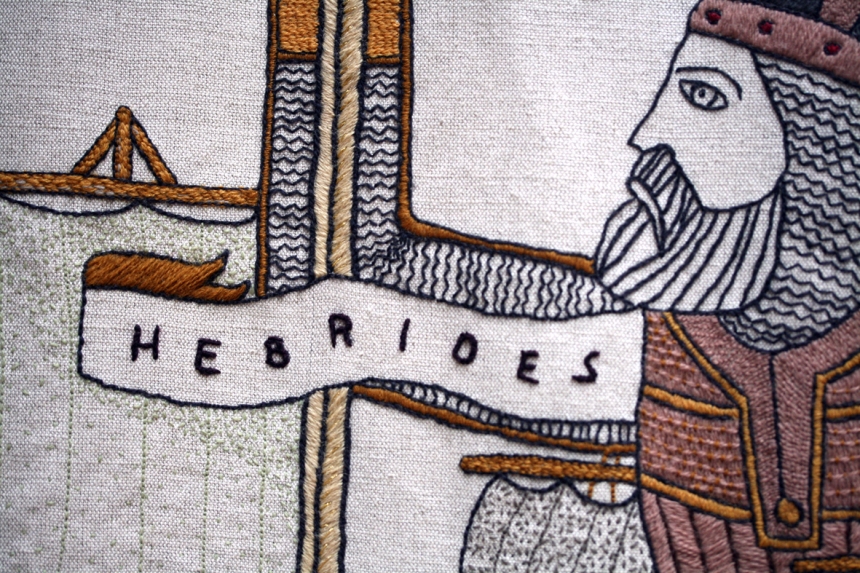
Panel 26: Somerled, first Lord of the Isles A beautiful panel, stitched in Lochaber.
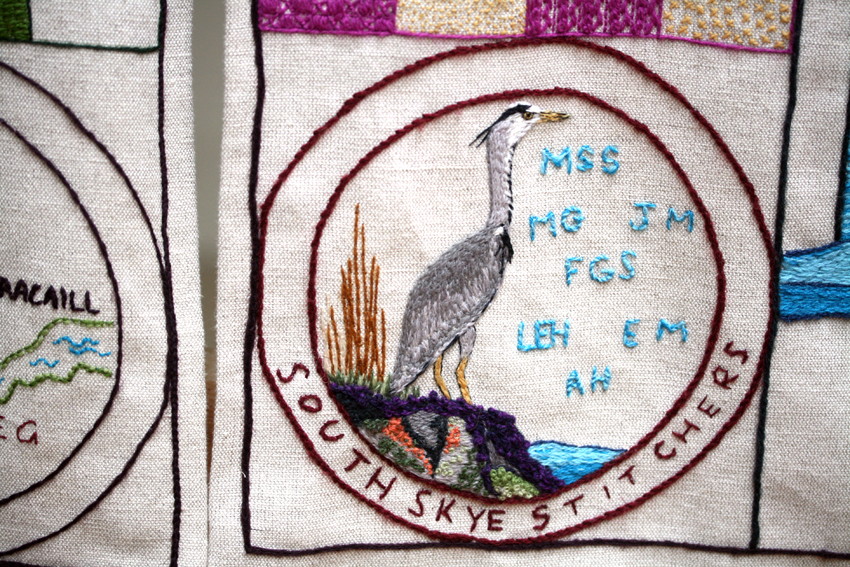
Panel 27: Haakon at Kyleankin. Signature of the South Skye stitchers who created this panel, which depicts twelfth century Norweigan / Scottish conflicts. The Orkney and Shetland islands remained in Norweigan / Danish hands until 1469.
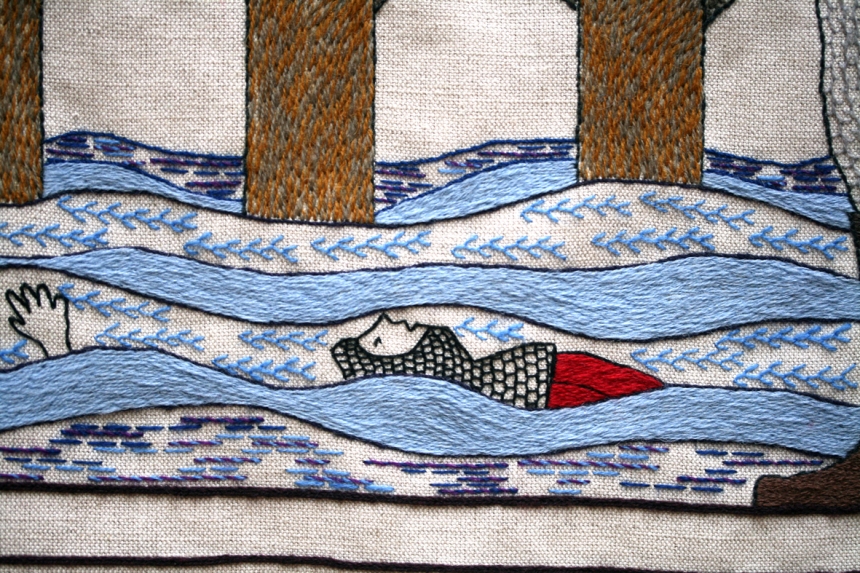
Panel 29: William Wallace and Andrew Moray. English soldiers drown in the river beneath Stirling bridge.
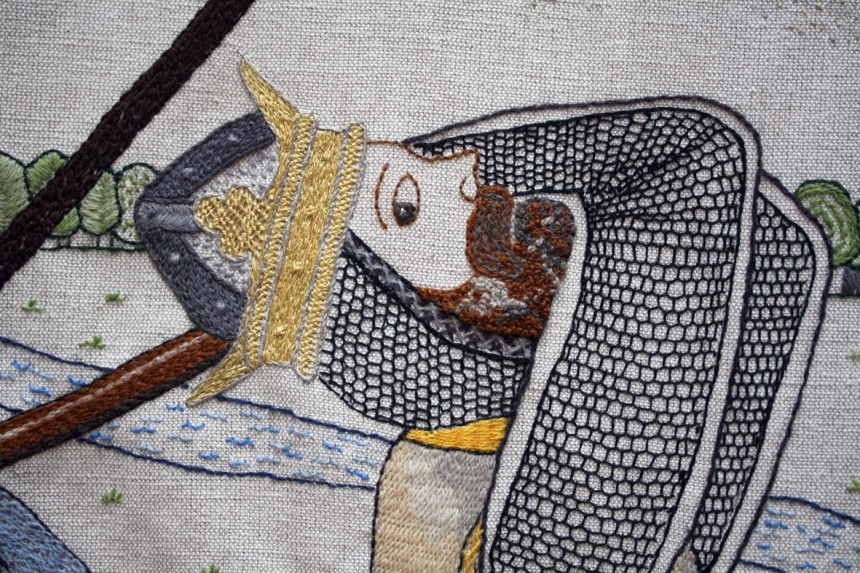
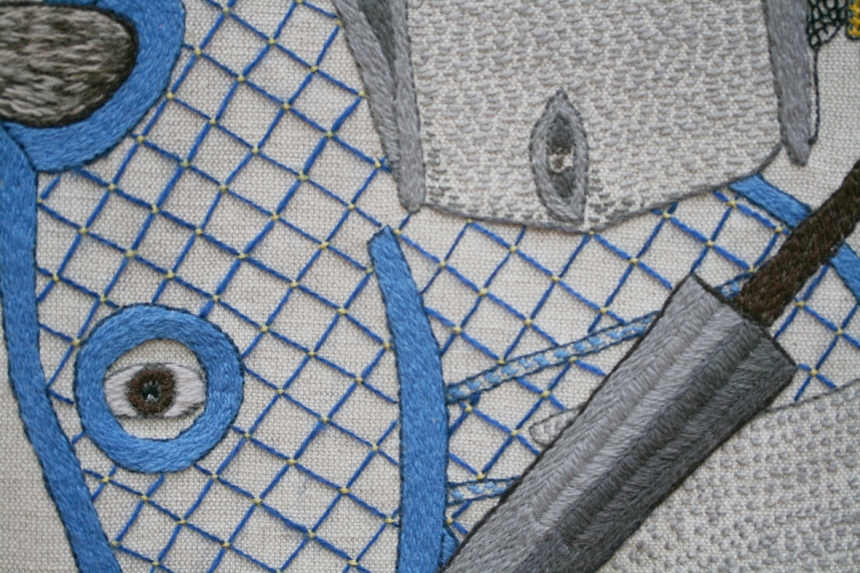
Panel 30: Bannockburn The stitching on this panel, created by Caroline M Buchanan and Margaret Martin, is incredible.

Panel 32: The Black Death Many affecting details on this panel, as the land is emptied of people.
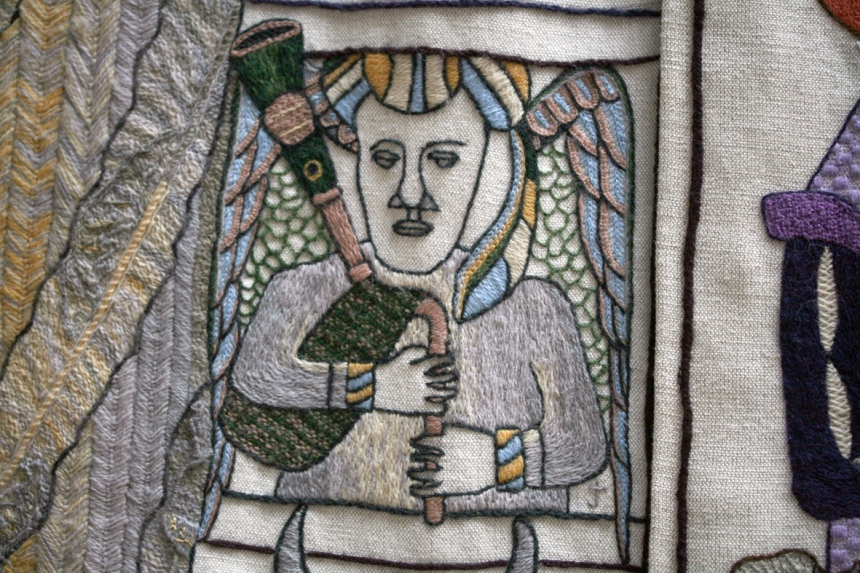
Panel 36: Rosslyn Chapel The famous piping angel of Rosslyn Chapel
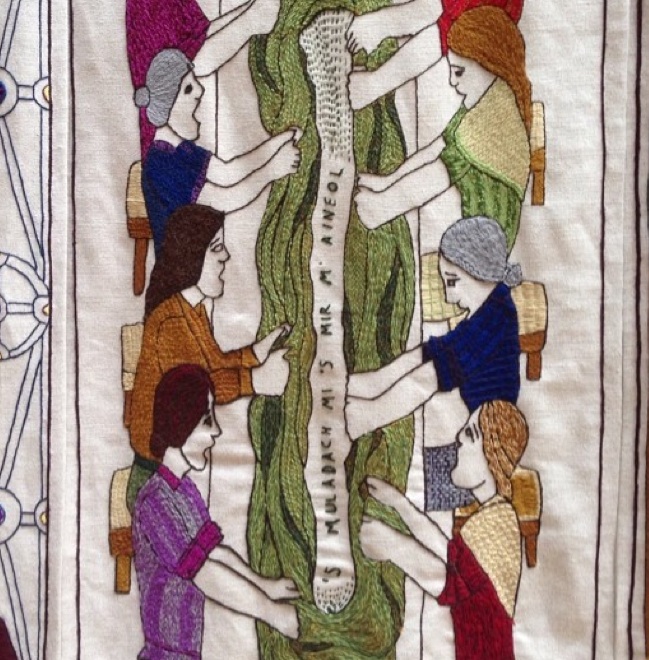
Panel 39: Waulking Love the strong arms and blithe faces of the women singing as they waulk the cloth.
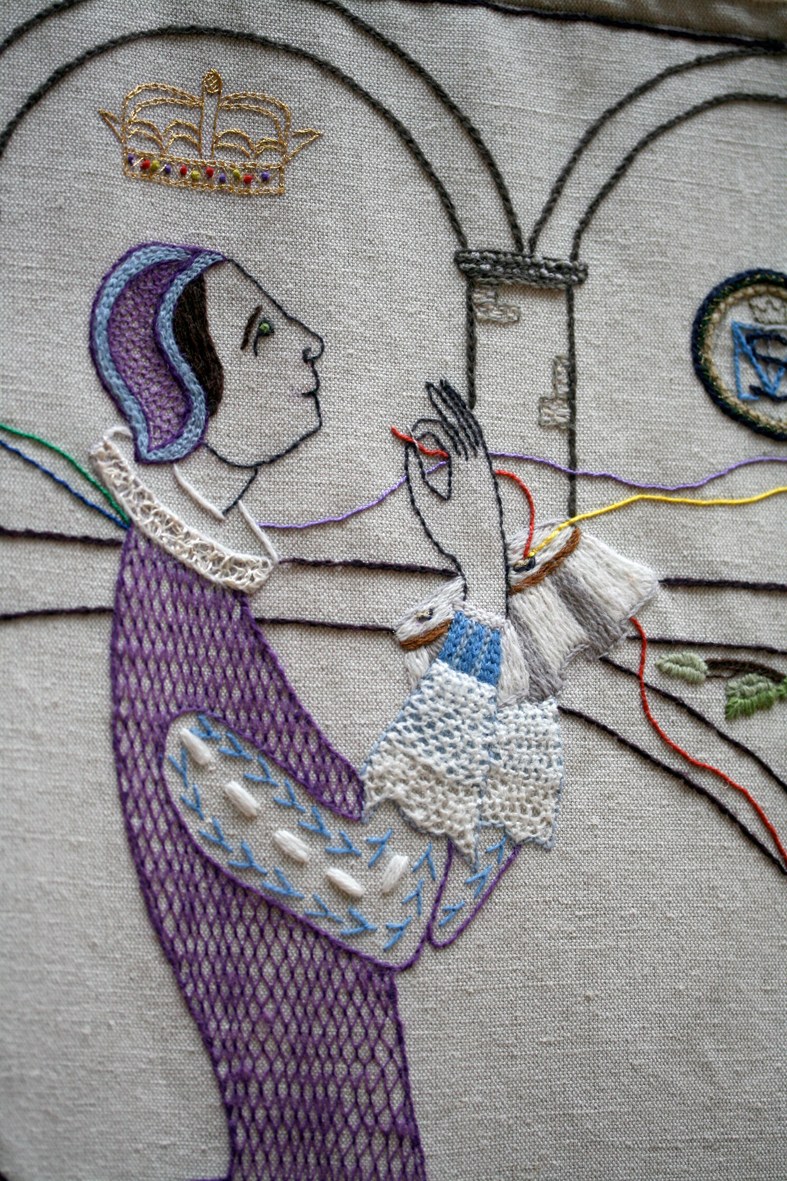
Panel 44: Mary Queen of Scots dreaming and stitching through her captivity.

Panel 45: The Border Reivers One of the tapestry’s many pleasing representations of Scottish sheep.
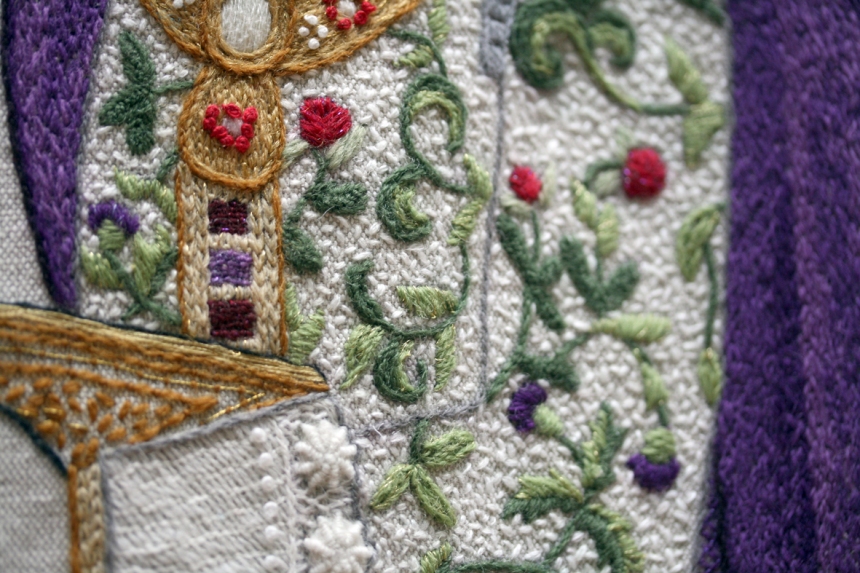
Panel 47: King James Bible The stitching of James IV’s jacket is incredibly beautiful, so minute, so precise – a perfect representation, in all respects, of seventeenth-century crewel work.

Panel 51: Droving One of many panels where Crummy’s drawings and the work of the stitchers inventively combine the human figure and the landscape. The figure of the drover emerges from and merges with the rolling hills and green fields.
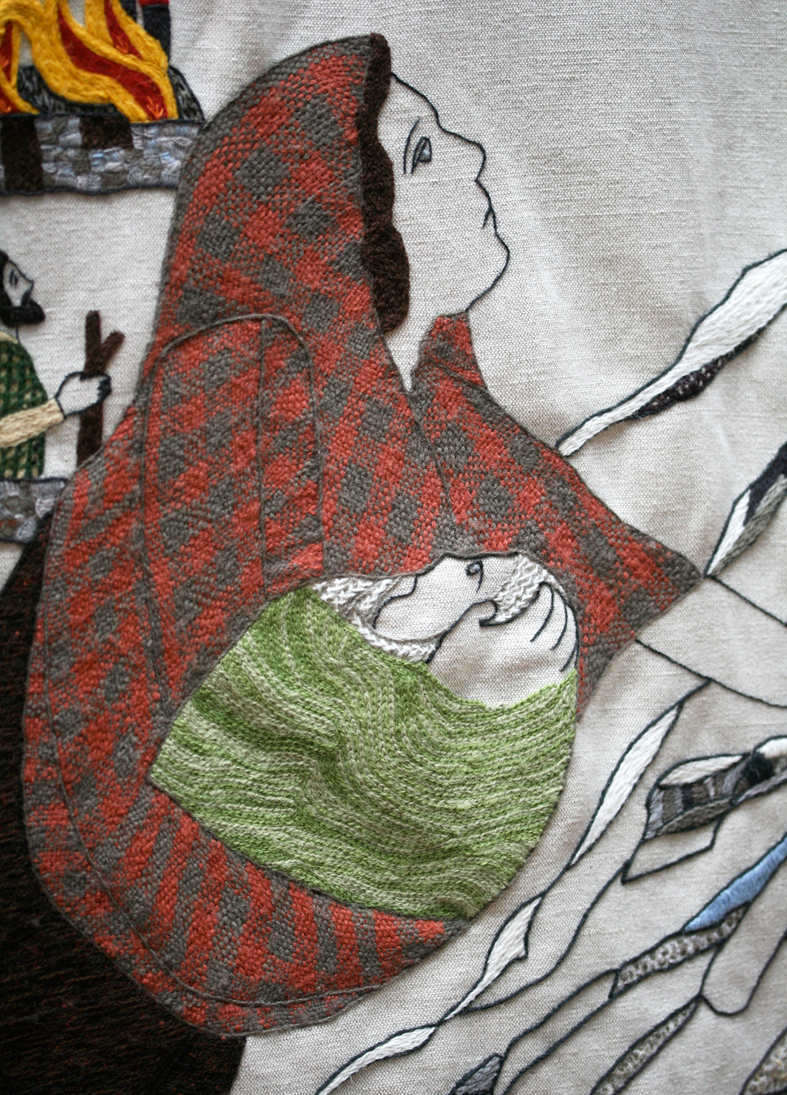
Panel 54: The massacre at Glencoe. The stitching here absolutely kills me. The way the weave of the plaid, and the folds of the cloth have been rendered is amazing.
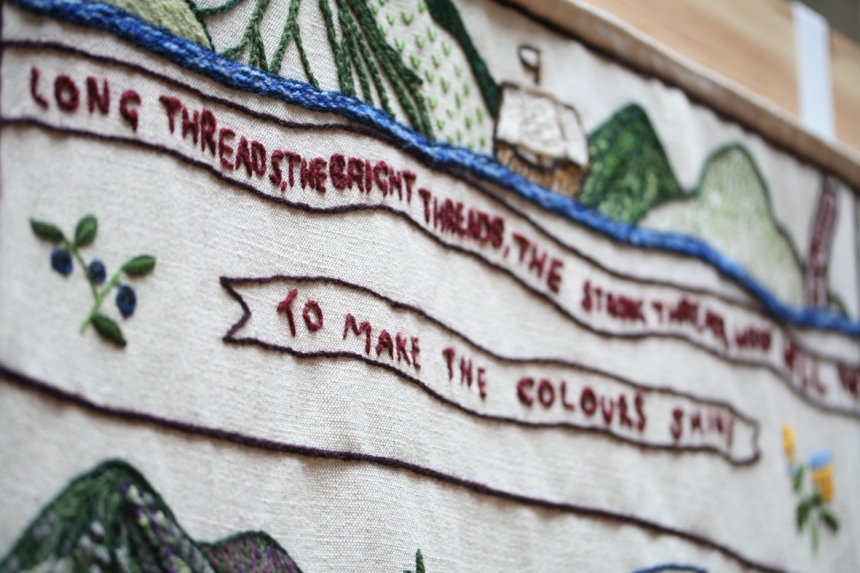
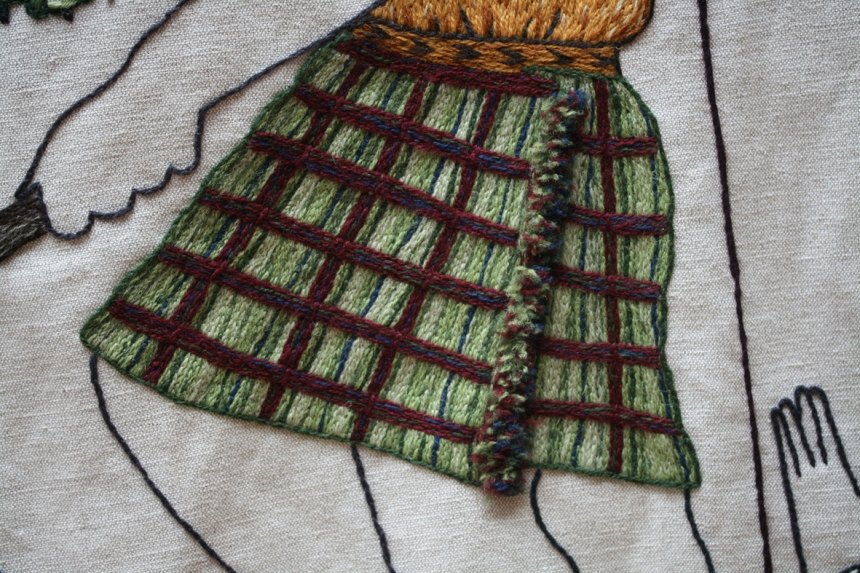
Panel 59: The Kilt Celebrating the invention of the ‘wee’ kilt in 1723. The wearing of kilts and tartans was shortly thereafter prohibited by the British government under the dress act of 1746.
More details tomorrow . . .

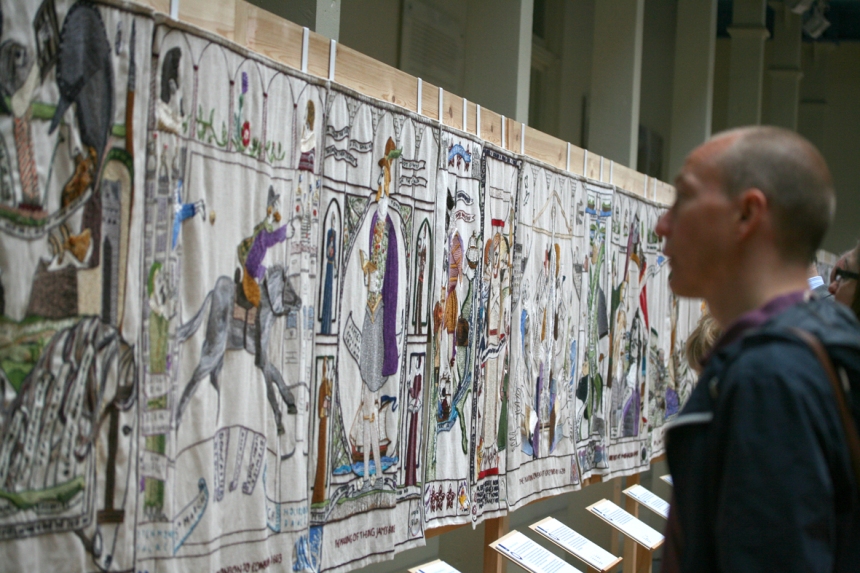
Amazing work! Is there a panel by panel post? Who organized this project? Thanks!
LikeLike
I’m really, really touched by your emotional description as I was one of the stitchers! Thank you for spreading awareness of this truly magnificent achievement. It’s hard to grasp the scale of it until you see it yourself!
LikeLike
thank you so much Kate. I am now plotting a ‘work’ trip to Edinburgh so I can go and see this too
LikeLike
I love that I managed to put some stitches on the Lisbon panel.
LikeLike
What a treasure! The plaid…oh the plaid!!! We have a project called the Quilt of Belonging in Canada. It was amazing to see in person. Some folks were lucky enough to see it several times. To hear attendees speak of and read some of the stories that went with each piece, added to its wonder!
Quilt of Belonging is 120 foot (36 metres) long collaborative textile art project, a richly hued portrait of the human family. Its 263 blocks portray the rich cultural legacies of all the First Peoples in Canada and every nation of the world at the dawn of the new Millennium.
See the quilt in our Photo Gallery. Experience this artwork in person, check Tour Dates. View each needlework block and learn about the culture of each Aboriginal and ethnic group in Block-by- Block. Order the autographed companion book Quilt of Belonging in the Bookstore. Follow our news at What’s New.
http://www.quiltofbelonging.ca
Thank you so much for sharing Kate!
LikeLike
What beautiful work! Thank you for sharing.
LikeLike
Thank you so much for sharing this in so much detail. I will probably never get to see it in person, but it is wonderful to get a taste of it through your beautiful photos. The concept was brilliant, the design even more so, and the stitching….there are no superlatives grand enough!
LikeLike
Wow, thank you for sharing this — I don’t know if I would have heard about it otherwise. As you say, it’s amazing both for its handiwork and for its interpretation of many diverse and complex pasts. As Canada approaches its 150th birthday, there’s increasing discussion floating around about how to commemorate the event, and frustratingly, much of it has focused on how to idolize dead white military/political dudes. So this tapestry is particularly inspiring to me because it offers a beautiful and skillful way to acknowledge and even celebrate a sense of a collective past without glossing over its complexities.
LikeLike
I cannot tell you how deeply these pictures move me. To think I was only a short way from Roslyn Chapel when I was doing my midder in Bangour…….now I am 6000 miles away! You have brightened my day with these panels. Thank you again.
LikeLike
Kate, you must go and see the other two tapestries- The Prestonpans Tapestry and The Scottish Diaspora Tapestry which had it’s premier in Prestonpans Community Centre at the end of May. We have seen all three and agree they are amazing, beautiful, inspiring, and I’m off to see the Great one again in Edinburgh taking a dozen friends along too!
LikeLike
Love, love, love! Thank you so much for sharing your experience of this treasure with us! (Two of my very favorites—history and arts-and-crafts.)
LikeLike
Absolutely FANTASTIC! Panel 54 looks like material and I keep looking at it to see stitches. I love them all.
LikeLike
Wow, this is so cool! Thanks for sharing :D
LikeLike
Gorgeous!
LikeLike
Amazing!
LikeLike
Oh my gosh–the plaid!!!
LikeLike
Thank you! Hoping to see it at New Lanark this autumn
LikeLike
Oh I do hope that they travel to Colorado. Magnificent. I liked the picture that showing the panels at a distance-the scope is equally as amazing as the detail.Kind of depressing to go home and work on my sad little cardigan compared with the stitching seen here.
LikeLike
Kate, once again I have to thank you for keeping me informed about my homeland! I didn’t know about the Kelpies until your post and now this breathtaking work! I will definitely be visiting both on my next trip home and I will be going sooner rather than later.
Your photos are beautiful and I am so looking forward to seeing it in person.
LikeLike
Thank you for showing us this tapestry! It is amazing and the needlework exciting to see!
LikeLike
How beautiful! Thank you. I was wondering if you know anything about the linen they used, and the thread? Specially made, dyed, etc?
LikeLike
That stitching kills me, too. If I didn’t know it was embroidery, I would have assumed they had just incorporated a piece of woven cloth.
Thanks for the tour of this tapestry, Kate. I’m enjoying it immensely.
LikeLike
This is fantastic, thank you for such great photos. Wish I could see it!
LikeLike
Thank you, Kate. I’m continually impressed with the quality of your photos, whether a landscape or a tiny embroidery detail. Can you share some information about your process? What kind of camera do you use?
Shelley
LikeLike
Thank you for posting the tapestry. It is beyond incredible.
LikeLike
Incredibly beautiful.
LikeLike
Thank you. It is lovely to see scenes come alive with the stitching.
LikeLike
Still totally gutted I missed this when it was in Aberdeen. I’ll have to make a special trip to the central belt to see it! Didn’t they have a bit at the end you could stroke? Thanks for the photos.
LikeLike
simply amazing…
LikeLike
I am just amazed and riveted by the tapestry. Thank you for sharing it with us; it truly deserves a world audience. Your photography skills are marvelous!
LikeLike
Thank you so much for posting these pictures – if there are any more do keep posting – would love to see the whole tapestry. This is the Scottish take on the Bayeux tapestry, if you haven’t seen it, it is time to pay a visit, it is truly a great wonder of the world!
LikeLike
Just so stunning! Just as I thought I had chosen a favorite panel….the next was even more so. The crewel work is not to be believed! Panel 51, the weaving, just incredible! I must search out the book.
Sheila
http://sheilazachariae.blogspot.com/2014/06/knit-some-sweet-hats.html
LikeLike
These are simply incredible!! What is the background fabric that the stitching is done on? Is it plain weave linen?
LikeLike
Yep, It’s truly brilliant. Saw it more than once when on display at Aberdeen Art Gallery a few weeks ago, and bought the book.
Loved the fact that it’s in panels. It’s a marvellous work and a fantastic teaching tool. It can and hopefully will be added to in the future.
Was delighted by the later sections that I had personal experience and memories of, and am ashamed to admit that I was slightly sceptical about it at first, and neglected to go and see it when it first went on display at Holyrood.
Thank you for the great photos, as I said, it’s TRULY BRILLIANT!
LikeLike
The woven plaid effect is incredible.
LikeLike
Thanks for much for posting these pictures, the panel is just amazing!
LikeLike
Takes your breath away! Love how lyrical the stitch work is and how the line and texture and stitches enhance the story and bring it to life.
LikeLike
I’ve been following the panels on Instagram, Kate, and they are just beautiful. I can’t get over the skill in rendering emotion in the faces all through the use of skillfully placed stitches, colors and textures. Thank you for sharing this, for taking the time.
LikeLike